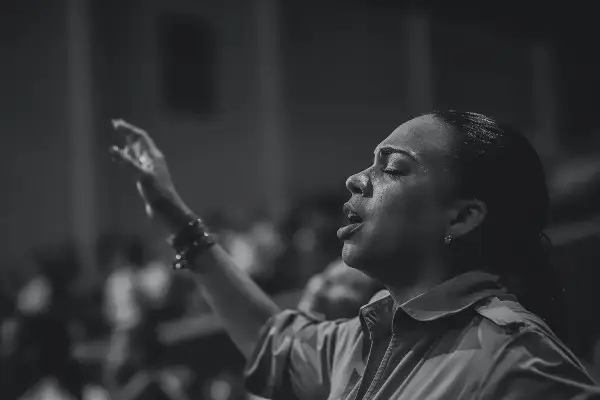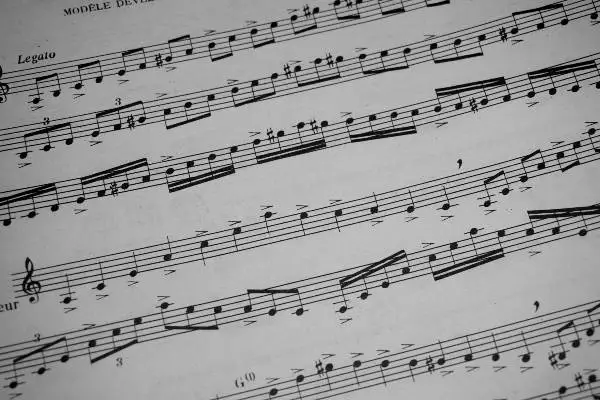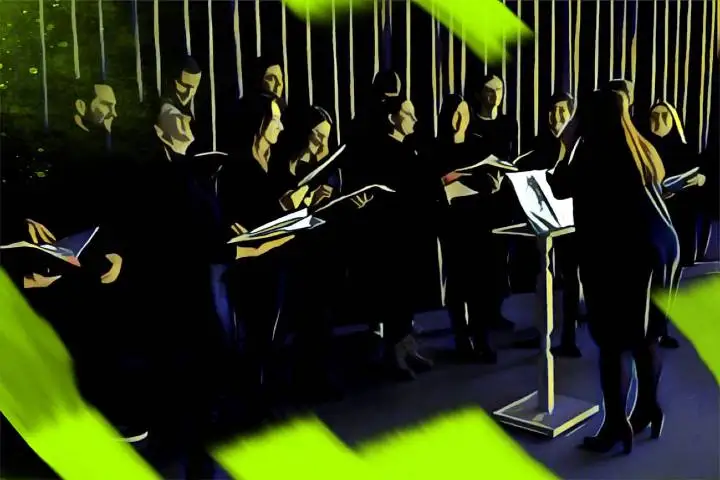Have you ever gotten "chills" while listening to music? This might've been caused by harmony. Harmony is one of the most sonically pleasing parts of music that makes listening to your favorite songs worthwhile. But what is harmony in music? And how can you recreate this technique in your music?
We'll answer all of these questions and more below. Let's dive into the magic of harmonies!
What Is Harmony In Music?
So what is harmony, anyway? You probably understand harmony intuitively, even without any knowledge of music theory. This is because harmony is simply two or more notes played at the same time in music. Whether you enjoy classical music or pop music, you're sure to find ample examples of harmony.
The two or more notes don't necessarily have to sound "agreeable" either. However, generally speaking, musicians utilize harmony music theory principles to create consonant chord progressions that sound pleasant to most listeners.
While some people may be able to figure out harmonies for a particular melody intuitively, there are ways in which you can manually figure out harmonies which we'll dive into below. In order to create harmonies, you'll have to commit to musical practice, but in time creating these tonal relationships will become second nature.
The Main Elements of Harmony
Harmonies are composed of a couple of key elements. Here are some of the basic music theory concepts that make up the foundations of tonal harmony.

Key Signature
The key signature determines how many sharps or flats are within a particular family of notes which is displayed at the top of the musical staff. A song's key typically determines the chord progression along with the major triad or minor triad which is essential for crafting intelligent harmonies.
Generally speaking, a minor key signature denotes a song with a more sad or mysterious tone while a major key signature has a happier, more upbeat tone. Keys also contain scales which are particular ways in which to play notes within a key. Oftentimes, the notes of a major scale or minor scale are a good baseline for creating harmonies.
Tonal Distinction
Most great harmonies are built off of a great melody . In order to create sonically pleasing intervals and interest within a composition, it's essential to have a tonal distinction or audible separation between different notes.
Consonant vs. Dissonant
Harmonies are composed of consonant and dissonant sounds. Typically, a consonant harmony feels open, sonically pleasing, and revolves around the same notes outlined in the chord progression of a song. Consonant chords are easy to listen to and show up all throughout modern music.
Dissonant harmonies, on the other hand, carry a lot of tension and can have a striking, sometimes unpleasant feel to them depending on the context. Dissonant chords may have more of a place in horror film music than on the radio, but they're certainly worth understanding.
Harmonic Change Rate
The rate at which song shifts from one chord to another in a musical composition can greatly influence your harmonic possibilities. In most popular western music, the chord changes every bar or every other bar .
Instrument Harmonics
Different instruments contribute varied harmonic structures depending on their tone and note quality. For example, a bass guitar might help highlight the tonic of a major chord progression in order to keep structure throughout the song.
Modulation
Modulation occurs when a composition steps away from the original key of the song. This key change can help denote a shift in music, and will also shift the harmonies of a track.
Rhythm
A lot of harmonic phrasing has to do with the rhythm or rate at which a melodic line is performed. A harmony can have the same rhythm as the melody line for a more subtle effect or a completely different phrasing for some additional contrast.
Chord Progression
The chord progression of a song has a lot of influence over the consonant harmonies in the song. Harmony involves chords since the strongest notes in a major or minor key typically revolve around the dominant chords of a composition. If you're struggling to create harmony in a particular piece, try following the notes of the established chord progression.
The History of Tonal Harmony In Music
Harmony originates from a Greek word meaning a joint between the planks of a ship or a joining of those planks. Greek music integrated the practice of singing multiple melodies at once, through Pythagorean or aristoxenian harmonic structure.
Different cultures emphasize different harmonic structures. For instance, South Asian art music places emphasis on an open fifth or fourth, staying on the same note. On the contrary, early western religious music featured parallel perfect intervals which have made their way into the western musical traditions of today.
One thing is for sure - harmony certainly influences the way we structure music as a whole.
Examples of Harmony In Music
There are plenty of examples of music harmony throughout all genres of eastern and western music, especially since even unison singing is considered a harmony. Here are a couple of common examples of harmony that you might recognize:
- The Beach Boys: The Beach Boys are known for singing extensive harmonies. Listen to any of their songs, and you'll find that each voice consists of a different harmony.
- Imogen Heap: The singer and producer Imogen Heap utilize harmonization in "Hide and Seek".
- Fleet Foxes: This alternative band is known for tight instrumental harmonies that contribute to their somewhat medieval soundscapes.
Harmony and Chord Classification
In western music, there are three different types of chords within a progression that determine the strength of melodies and harmonies.
Tonic
Tonic chords are normally the lead of the progression. This is where the chord progression feels the most stable.
Dominant
The second most important chords are the dominant chords. These chords are built on the 5th degree of a particular scale.
Predominant
Predominant chords are used to bridge the harmonic gap between the tonic and dominant chords.
What Are The Different Types of Harmony?

Harmony can be broken down into three main categories. Here's everything you need to know about the different types of harmony.
Diatonic Harmony
Diatonic harmony refers to music harmony where all of the notes and chords can be traced back to a single major or minor scale.
Non-Diatonic Harmony
Non-diatonic harmony is similar to diatonic harmony since it revolves around a song's central scale for the most part. However, non-diatonic harmony also introduces notes outside of the tonic chord structure, which can create tension and add interest to a melodic phrase.
Atonal Harmony
Atonal harmony disregards key altogether, considering all twelve semitones equally important within any sonic structure. Chord forms don't affect this type of harmony which is embraced by more experimental music movements like free jazz.
The Difference Between Open and Close Harmonies
The terms open and close in relation to harmony describe how close each note is within a cord in tonal music. In close harmony, all the notes are as close as possible. Open position chords are much more spread out to where the tonic could be more than an octave away from the other two notes in a chord.
An open harmony can help create a less dissonant chord structure by creating more space within a sonic space for a sweeter sound.
What Is Implied Harmony?
An implied harmony comprises of key notes within a particular chord structure that are able to identify a particular chord without all notes being explicitly played. Since different musical instruments can only play one note at a time, implied harmony in tonal music can make up for missing parts.
Let's take the C major triad for example, typically, a C major triad would have the notes C, E, G. However, if you play the notes "C" and "G" in the key of C major, your ears could still identify the major chord structure without the minor third "E". Implied harmonies are heavily embraced in the jazz world, though they can be found in a wide variety of music.
How To Write Harmony
Writing harmony is an excellent practice that will improve your skills as a musician as a whole. Here is an easy roadmap if you don't know where to begin.
- Find your melody first. In order to create harmony, you need a melody to start. Write your melody before moving onto your harmonic line.
- Experiment with an instrument or your voice. Sometimes, harmony can be created through improvisation. See if playing or singing over your melody produces harmony.
- Use chords for inspiration. When in doubt, look to the notes in your dominant chords. Common intervals in dominant chords like perfect 4th and perfect 5th can make amazing harmonies to your melody.
- Build off of a scale. Using a scale is another way to make strong diatonic harmonies. Take a scale and make another melody line with separate notes as your harmony.
Tips For Singing Harmonies
Here are some quick tips for singing harmonies if you're just getting started.
- Sing in a group. Are you still struggling to understand, "what is harmony in music"? In which case, joining a choir can help you better understand the layering of different melodies. Joining a choir is great harmonic practice and will help tune your ears with regular practice.
- Use musical instruments as an aid. In order to create accurate harmonic interval jumps, it's a good idea to use a musical instrument to play harmony before singing it. It's a lot easier to sing in key when you're playing the same note on your tuned guitar or piano.
- Listen critically to harmonies in music. Whenever you're playing chords or casually listening to music, try to take note of harmonies. It's good practice to try and identify the individual parts which can, in turn, help you sing stronger individual parts.
- Practice creating and writing harmonies. There's no substitute for practice! Take the time to write both open harmony and closed harmony. The practice of manually working through harmonies will make it easier for you to sing and understand the music theory behind harmonies.

Harmony FAQs
Are you still struggling to grasp the concept of harmonies? Have no fear! Here are some commonly asked questions and answers to expand your understanding.
How do I find the harmonies of a song?
Harmonies are technically just more than one note played simultaneously. That being said, some of the most sonically pleasing harmonies revolve around the major tonic chord of a song. Take the root note of the key and play the 3rd and 5th notes of the major scale.
How do you identify harmony?
Whenever more than one note is played at the same time, you have harmony. To identify harmony, look for tones sung outside of the main melody. Oftentimes, you can find harmonies in the pre-chorus and chorus section of songs , though this isn’t always applicable.
What is the difference between melody and harmony?
Harmony is based on a melody. Melody is the main tonal phrase in a song, while harmony serves to complement the melody with different notes. In terms of different types of singing , the melody is often sung by soprano singers, while alto singers take over the harmony in most cases.
What is the difference between rhythm and harmony?
Harmony has to do with the tonal information of a song in relation to the melody. Rhythm speaks to the cadence or the way in which a melodic phrase is expressed by a singer or instrumentalist. Harmony and melody can have similar or completely different rhythms depending on the needs of a song.
What is the difference between harmony and counterpoint?
Counterpoint refers to the practice of creating a single melodic phrase utilizing more than one voicing, usually relying on a harmonic structure. Harmonies, on the other hand, are simply multiple notes played at the same time to support an existing complete melody.
What is two-part harmony in music?
Two-part harmony refers to someone singing a melody, and then the harmony voicing singing within the existing chord structure or on the same staff of the melody line. Two-part harmony is fairly common due to its simplicity and sonically pleasing sound.
Can you have harmony without melody?
You can have harmony without a distinct melody - Since harmony is just more than one note played at the same time, technically even a chord progression utilizes harmony in principle. In this way, practically all music utilizes some form of harmony regardless of genre and era.
Are drums melody or harmony?
Drums aren’t necessarily a melody or harmony - they’re more of a rhythmic part more than anything else. While it’s true that drums can have distinct tones to them, they are known for carrying melodic information to create melody or harmony.
Is harmony a chord?
Harmonies aren’t necessarily a chord (they are more flexible), but a chord is always a harmony since harmony is simply multiple distinct tones played at the same time. Harmonies are usually built around a specific chord structure in relation to the melody.
Is harmonizing easy?
Harmonizing can be challenging for any beginner, just like any other skill. That being said, it can become second nature with enough practice under your belt. Learning how to play chords and improvise over a melody can make it easier for you to intuitively harmonize.
Simply put, harmony in music is two or more notes played at the same time. While this concept isn't super complicated, it can make a huge difference in the quality of your songs and mixes. Enjoy incorporating harmonies into your music!





